Speech A Journey Towards a Near Cashless Payments System
Thank you for the opportunity to address the Australian Payment Summit. The world of payments has become increasingly exciting, so it is very good to be here today to share in that excitement.
This morning I would like to speak about the shift towards electronic payments; or as the title of my remarks says, the journey towards a near cashless payments system. For some decades, people have been speculating that we might one day go cashless – that we would no longer be using banknotes for regular payments and that almost all payments would be electronic. So far, this speculation has been exactly that – speculation. But it looks like a turning point has been reached. It is now easier than it has been to conceive of a world in which banknotes are used for relatively few payments; that cash becomes a niche payment instrument.
Given this, I would like to structure my remarks around three broad points.
The first is that the shift to electronic payments is occurring quite quickly and it is likely to continue. This shift is a positive development that should promote our collective welfare.
The second is that if we are to realise the benefits of moving to a near cashless payments system, the electronic system needs to offer the functionality, safety and reliability that people require. People need to have confidence that the electronic payment system will be operating when they want to make their payments and that it will deliver the payment services that they need.
The third point is that as we undertake this journey towards a near cashless payment system, there will be a greater focus on the cost of electronic payments. If almost all payments are electronic, then the cost of making these payments matters more than it used to. The electronic system needs to be as efficient as it can be and to be characterised by strong competition. In my view, there is further work to be done here.
1. The Shift to Electronic Payments
The Reserve Bank conducts regular surveys of how Australians make their payments. The next survey will be undertaken in 2019. Until then, perhaps the best illustration of the declining use of cash for transactions is the sharp decline in the number and value of cash withdrawals through ATMs (Graph 1). Around the turn of decade, Australians went to an ATM, on average, around 40 times per year. Today, we go to an ATM around 25 times a year and the downward trend is likely to continue.
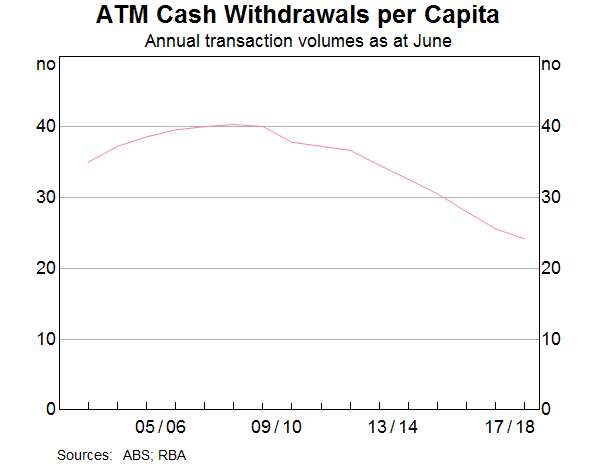
At the same time as the use of cash for payments has been declining, the number of electronic transactions has been growing strongly (Graph 2). Today, Australians make, on average, nearly 500 electronic payments a year, up from around 100 per year around the turn of the century.
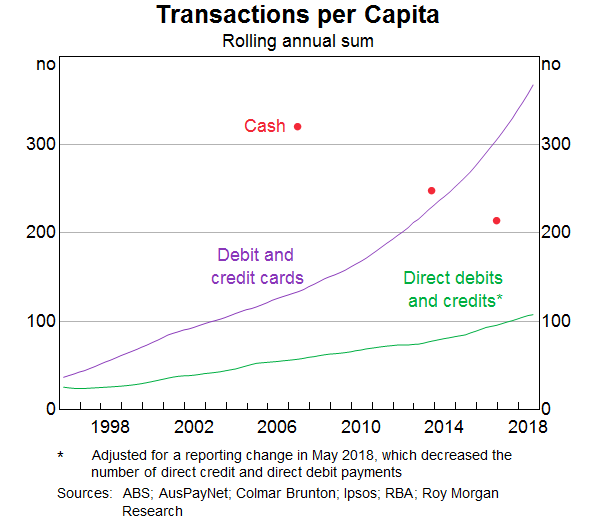
New payment technologies are being developed that will further encourage this shift to electronic payments. Perhaps the most significant of these is the New Payments Platform, which has made it possible for people to make real-time person-to-person payments without using banknotes. A range of payment apps are also under development that would have the same effect. So the direction of change is clear.
There also continues to be a decline in the use of cheques (Graph 3).[1] In the mid 1990s, Australians, on average, made around 45 cheque payments per year. Today, we make around three per person. Given this trend is likely to continue, it will be appropriate at some point to wind up the cheque system, given the high fixed costs involved in operating the system. We have not reached that point yet, but it may not be too far away. Before we do, it is important that alternative payment methods are available. Progress has been made on this front, but more is required.
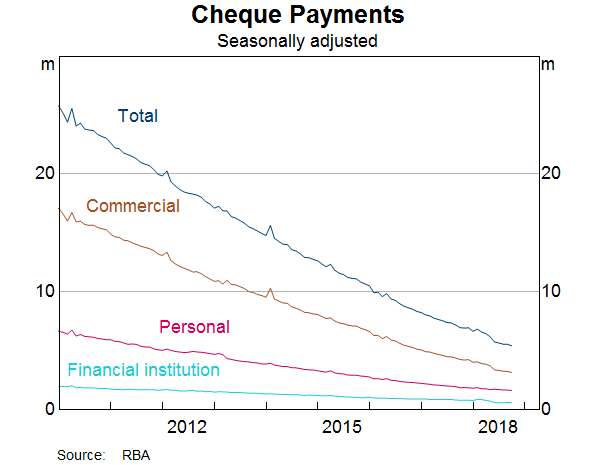
It is worth pointing out that despite the decline in cash use, the value of banknotes on issue, relative to the size of the economy, is close to the highest it has been in fifty years. For every Australian there are currently around thirty $50 and fourteen $100 banknotes on issue (Graph 4).
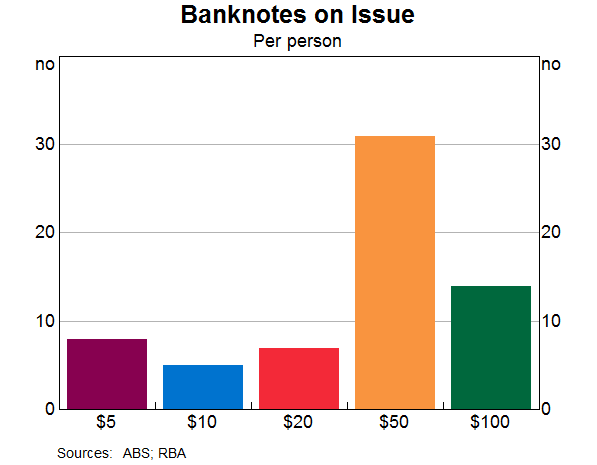
So there is an apparent paradox between the declining use of cash and the rising value of banknotes on issue. The main explanation is that some people, including non-residents, choose to hold a share of their wealth in Australian banknotes. The opportunity cost of doing this is less than it used to be because of the low level of interest rates.
While it is difficult to predict the future, I expect that banknotes will remain part of our payments system for some time to come.
In some situations, paying with banknotes is quicker and more convenient than paying electronically, although this advantage is less than it once was. Some people also simply prefer paying in cash – our 2016 survey indicated that around 14 per cent of Australians had a preference for using cash as a budgeting tool.
Banknotes also allow payments to be made anonymously in a way that is not possible in systems that leave an electronic fingerprint. This privacy aspect is valued by some people. In some circumstances this desire for privacy is entirely legitimate, but in others it has more to do with tax evasion and illegal activities.
Perhaps a more important source of ongoing demand is the fact that using cash does not require the internet to be up, electricity to be working and the banks' systems to be operational. Banknotes are therefore an important emergency or back-up payment instrument. They are particularly useful in the event of natural disasters or failure of the electronic system. Perhaps one day the various systems will be so reliable that a backup will not be needed, but that day still seems some way off.
Overall, the shift to electronic payments that is occurring makes a lot of sense – it is similar to other aspects of our lives where things that used to be physical have been supplemented with, or replaced by, technology. This shift is likely to promote our collective welfare. I say that even though the Reserve Bank is the producer of banknotes and earns significant income, or as it's known, seigniorage, for the taxpayer from their use. The greater use of electronic payments can bring efficiency benefits, with lower costs and more functionality and choice for users. One example of this is the reduced tender time involved in card transactions due to contactless technology. There are also non-trivial production and distribution costs involved in the cash system. Some of these are fixed costs, so the average cost of cash transactions is likely to rise as the volume of cash transactions falls. Looking ahead, there is also more limited scope for fundamental innovation in the cash system compared with the scope for dynamic innovation in electronic payments. So this journey is in our national interest.
2. Functionality, Safety and Reliability
I would now like to discuss three interrelated factors that will influence how quickly we undertake that journey. These are: the functionality offered by the electronic system; the safety of that system, and the reliability of that system. The other factor that is also relevant is cost, and I will touch on this a little later.
Functionality
The rapid adoption of contactless payments in Australia shows that Australians change how they pay quite quickly when new functionality is offered. Contactless card payments were slow to take off but once critical mass was established, they grew very quickly. In our 2013 consumer payment study they accounted for around over 20 per cent of point of sale card payments; three years later they accounted for over 60 per cent. So the functionality of the electronic payments system is key.
The development of the electronic payment system took a major step forward earlier this year with the launch of the New Payments Platform (NPP). This system allows people to make payments 24 hours a day, 7 days a week, using just a simple identifier such as a mobile phone number or an email address. It also allows a lot of information to accompany the payment. I expect that over time this extra functionality will further reduce the use of cash in the economy and also improve the efficiency of the electronic system.
The number of transactions through the NPP is steadily increasing (Graph 5). After a relatively low-key start, there are now around 400,000 NPP transactions per day. Over 2 million PayIDs have also been registered, and we expect further growth as the banks continue to roll out services to their customers.
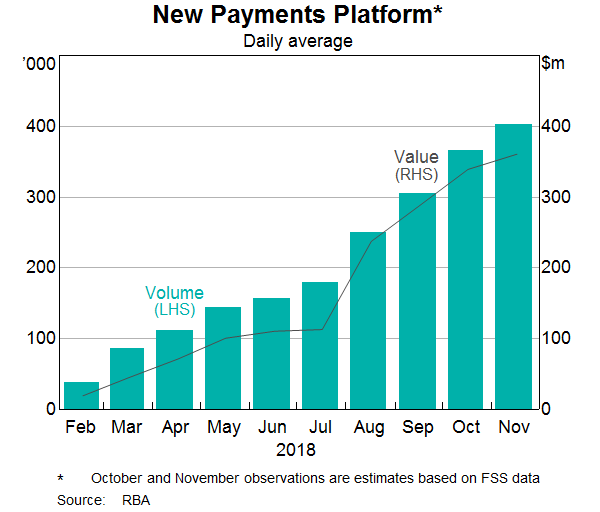
The concept behind the NPP is that so-called ‘overlay’ services are developed, and that these overlay services offer new functionality that utilise the real time capability of the NPP. The first overlay service provides for a basic account-to-account payment. Among the subsequently planned overlay services are ones that will allow someone to send a request to pay, perhaps to a friend for their share of a meal out. Another overlay service would allow a link to a document to be sent with a payment; this could be a payslip or a detailed record of the transaction.
It was originally anticipated that these two overlay services would be up and running not long after the NPP launch. Unfortunately, this timeline has slipped. A number of the major banks have also been slower than was originally expected to roll out NPP functionality to their entire customer bases. This is in contrast to the capability offered by smaller financial institutions, which from Day 1 were able to provide their customers with NPP services. Given the slow pace of roll-out by the banks, and the prospect of delays for additional overlay services, I recently wrote to the major banks on behalf of the Payments System Board seeking updated timelines and a commitment that these timelines will be satisfied. It is important that these commitments are met.
It is worth observing that in other countries where banks have been slow to develop payment applications that meet the needs of the public, other possibilities emerge. China is perhaps the best example of this, with the emergence of QR-code-based payments. I expect that the NPP infrastructure will be the backbone of our electronic payments system for many years to come. But for this to be the case, the system will need to provide the functionality that people require, and it will need to do this on a timely basis.
There are a range of fintech firms that are excited by the capabilities offered by the NPP and the potential for it to be used for innovative payment solutions. In October, the RBA issued a consultation paper seeking views on the functionality and access arrangements for the NPP. In particular we are interested in views on whether the various ways of accessing the NPP, and their various technical and eligibility requirements, are adequate for different business models.
A topic that I get asked about from time to time is whether the functionality of the electronic system would be enhanced by the RBA issuing an electronic version of the Australian dollar, an eAUD. I spoke about this issue at this conference last year, concluding that we did not see a public policy case for moving in this direction at the time. In particular, it is not clear that RBA-issued electronic banknotes would provide something that account-to-account transfers through the banking system do not, particularly with the emergence of the NPP. Another important consideration was the implications for financial stability. A year on, our views have not changed.
Security
A second important influence on the rate at which we shift to a more electronic payments system is the public's confidence in the security of the system.
Given this, a recent focus of the Payments System Board has been the high and increasing level of fraud in card-not-present transactions (Graph 6). Card-not-present fraud rose by 15 per cent in 2017 and now represents 87 per cent of total scheme card fraud losses.[2] In contrast, the industry has had successes in addressing card-present fraud, with the introduction of chip technology and the switch to PINs. Despite this, growth in e-commerce activity has provided new opportunities for would-be fraudsters.
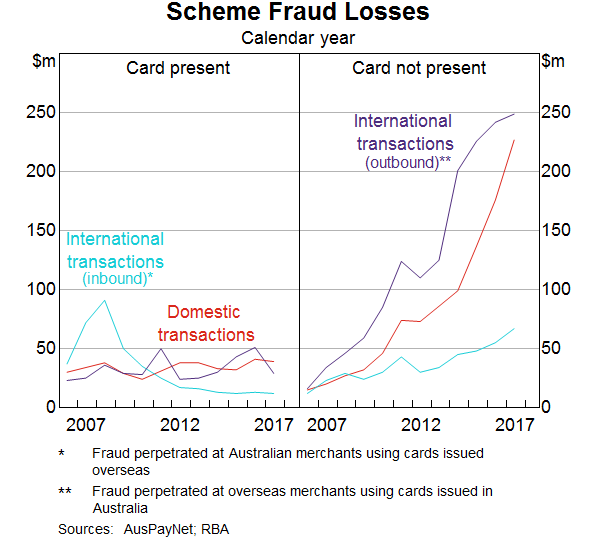
The Payments System Board identified the rise in card-not-present fraud as a priority for the industry. In August this year, the Board was pleased to welcome AusPayNet's publication of a draft industry framework to mitigate card-not-present fraud, and supports continued collaboration on this issue.
A separate but not unrelated priority for the industry is to progress work on digital identity. This is another area where barriers to effective coordination can arise. I am pleased that AusPayNet is undertaking work here, under the auspices of the Australian Payments Council. Digital identity is likely to become increasingly important as more and more activity takes place online. The RBA is highly supportive of industry collaboration on this issue and views it as important that substantive progress is made.
More broadly, individuals, businesses, governments and financial institutions all need to be aware of cyber risks. In the RBA's most recent Financial Stability Review we noted the increasing sophistication of cyber attacks and that regulatory authorities have increased their focus on cyber issues.
Reliability
A third factor is the confidence that people have that they will be able to use the electronic system when they need to make their payments. As I noted earlier, people will still want to hold and use banknotes if they can't be sure that the electronic system will be available when they need it. In our consumer payments survey in 2016, we asked people about why they held cash in places outside of their wallet. The most common response, from nearly half of respondents, was that it was for emergency transaction needs.
Over recent times, there have been a number of serious operational incidents that have interrupted the payments system. On some occasions these have been caused by problems with the telecommunications companies and at other times by problems at the banks. An operational incident at the RBA in August as a result of problems with a routine fire test also saw a number of RBA core systems unavailable for some hours, including the Fast Settlement Service supporting the NPP.
We all need to do better here. As we rely less on cash, outages affecting retail transactions can have a significant impact on businesses and individuals. So continued effort needs to be made by all participants in the payments system to reduce operational problems. If this does not happen, then it is possible that the Payments System Board could consider setting some standards.
3. Increased focus on Cost and Competition
My third broad point is about the cost of electronic payments and the importance of competition.
As we move to a predominantly electronic world, there will be more focus on the cost of operating the electronic payments systems and how those costs are allocated between those making and receiving payments.
Looking forward, I expect that over time the cost of electronic payments will decline further, due to both advances in technology and economies of scale. Even so, there are significant costs to operate the electronic systems, including costs for front- and back-end systems to maintain accounts, and to deliver functionality and convenience to users, as well as costs in preventing fraud and ensuring resilience. How these costs are managed and who pays for them will have a significant bearing on the efficiency of the overall system.
In terms of card payments, merchants in Australia currently pay less than merchants in many other countries. The comparison with the United States is particularly stark (Graph 7). For credit cards, Australian merchants, on average, pay 0.8 per cent of the transaction value for Mastercard/Visa transactions. In the United States the figure is much higher at around 2.2 per cent. There are also differences in the cost of debit cards and American Express cards between the two countries.
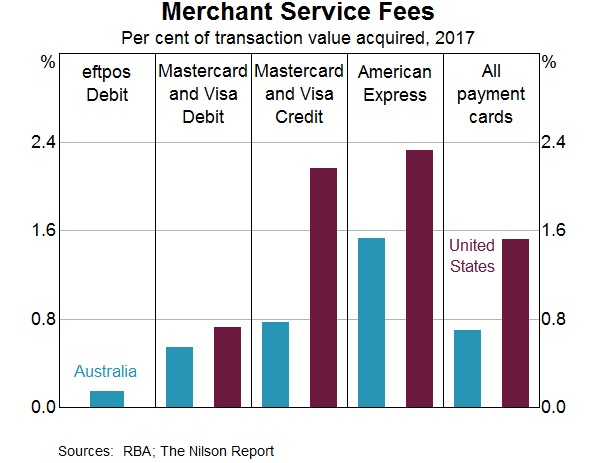
The main reason for the lower merchant costs in Australia is our lower interchange fees. These fees were reduced in Australia as a result of regulation by the Reserve Bank commencing in 2003. The RBA's reforms reduced average interchange fees in the Mastercard and Visa systems by around 45 basis points. This has been reflected in merchant service fees; indeed, these merchant fees have fallen by somewhat more than the cuts to interchange, likely reflecting an increased focus on card acceptance costs by merchants (Graph 8). In addition, as a result of competitive pressure, including from the removal of no-surcharge rules, fees on American Express and Diners Club have also fallen over time.
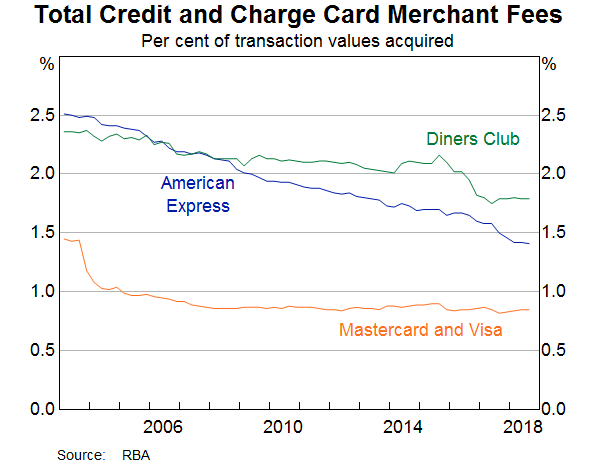
Notwithstanding the reduction in interchange fees, these fees still represent, on average, around 60 per cent of the total merchant service fee on credit cards. So they remain an important part of the total cost to merchants. Conversely, these fees mean that the cardholder's bank gets paid each time the card is used. This has meant that the cost to consumers of using these cards is often low; in some cases, cardholders are actually subsidised to use their card, through reward points and/or interest-free credit. The subsidy is provided by the cardholder's bank, but ultimately paid for by the merchant.
The close link between interchange and merchant costs means that there continues to be significant focus on interchange and its implications for the distribution of costs between merchants and consumers. For example, there have been recent recommendations from the Black Economy Taskforce and the Productivity Commission for the Reserve Bank to consider regulatory action to lower, or even ban, interchange fees. The Payments System Board will again examine the arguments for lower interchange fees when it next conducts a formal review of the card payments system.
On the competition front, one area that merits close attention is the market for acquiring services. This has come into sharper focus as a result of concerns about the costs to merchants in the debit card system, where most cards allow for transactions to be processed by either of the two networks enabled on the card. The longstanding view of the Payments System Board has been that merchants should at least have the choice of sending the debit payment through the lower cost system, whether that be eftpos or the international scheme.
For merchants to be able to do this though, acquirers need to offer terminals and technical systems enabled to allow least-cost routing. Some acquirers have already completed the necessary work and are attracting new merchants. Others, including the major banks, made commitments earlier in the year regarding the timetable for this work to be completed. Partly on the basis of those commitments, the Payments System Board made a decision not to regulate. Since then, I regret to say there has been slippage by some, who have cited technical problems. It is important that the banks get back on track here. A failure to deliver on commitments or to provide the payment services that the community needs will inevitably lead to calls for further regulation.
4. Looking ahead
Looking beyond interchange and acquiring competition, new technologies open up the prospect of new payment options developing. Recently, there has been much discussion on the role that so-called ‘Big Tech’ firms might eventually play.
These firms have potential advantages over existing providers of payments services. In some cases, their technology and systems are more flexible, they have a greater ability to use and process information, they have well established networks which they can leverage and they are often better at interacting with their users and customers. Given this, one scenario is that these firms become significant players in the payments industry. They might be able to do this through developing new payment applications that provide a commercial return, not through charging for payment services, but by commercialising the value of the information that they obtain as a by-product of offering these services. If this scenario were to play out, it could significantly change the payments landscape, providing both merchants and consumers new payment options at low monetary cost. At the same time though it would raise a number of important issues related to data privacy, ownership and security.
The probability of Big Tech firms entering the payments arena is higher if merchants and consumers feel that the existing payment systems do not offer them the services they need and/or the prices that are being charged are too high. As I noted earlier, where banks have been slow to respond, other payment applications have emerged.
This scenario highlights a broader point. The way that people are charged for payments is complex and is changing: among other things, it is influenced by interchange fees, how the value of information is commercialised, and commercial pressures on banks. It is difficult to predict how things will ultimately play out, but these are issues the Payments System Board continues to keep a close eye on.
5. Summing Up
To conclude, I expect the shift to electronic payments will continue. The issues of functionality, security and reliability, and cost are central to the development of the system. The Payments System Board will be keeping a close eye on these issues.
While I have talked about a near cashless payments system, I want to emphasise that we don't yet envisage a world without banknotes. The RBA is committed to providing cash consistent with demand by users and to support its distribution. Our development of the Next Generation Banknote series is a clear commitment to ensuring that cash continues to have public confidence and to meet the needs of the community.
The launch of the NPP this year was a big step forward for the industry and a credit to all of the staff at participating organisations who worked hard over the life of the project to bring it to fruition. As I mentioned, there are some key things that need to be done for the full benefits of the NPP to be available to end-users, but I am optimistic that these can be achieved and this new infrastructure can provide great functionality for Australia.
Endnotes
I would like to thank David Emery and Tony Richards for assistance in the preparation of this talk. [*]
For a more detailed discussion of cheques, see Tellez (2017), ‘The Ongoing Decline of the Cheque System’, RBA Bulletin, June. [1]
Fraud statistics are published every half-year by Australian Payments System Limited (AusPayNet) (2018), Fraud Statistics, available at <https://www.auspaynet.com.au/resources/fraud-statistics>, accessed 22 November 2018. [2]
